Translate this page into:
Correction of Gummy Smile in a Patient of Vertical Maxillary Excess Using Absolute Anchorage System
Address for correspondence: Dr. Ekta Lahoti, 50E, K. M. Naskar Road, Opp. I.T.I Tollygunge, Kolkata - 700 040, West Bengal, India. E-mail: 13ekta@gmail.com
This article was originally published by Wolters Kluwer and was migrated to Scientific Scholar after the change of Publisher.
Abstract
This article presents the orthodontic treatment of a 24-year-old female patient with gummy smile and proclination along with a hyperdivergent profile. The patient showed excessive gingival display in both the anterior and posterior areas in the maxilla. Such situation in an adult patient often demands surgical therapy. However, due to patient reluctance toward surgery, the gummy smile was treated by the intrusion of the whole maxillary arch. After alignment and leveling, absolute anchorage system as well as a modified transpalatal arch was designed to achieve posterosuperior movement of the entire upper dentition. The active treatment period was 2.3 years.
Keywords
Absolute anchorage
facial profile
gummy smile
hyperdivergent
intrusion
Introduction
In recent times, mini-implants have been used for multiple purposes – for correction of gummy smile with increased anterior facial height by full maxillary arch intrusion; deep bite correction by intrusion of incisors; and open bite correction by molar intrusion.[1-4] In 2003, Paik et al.[1] treated vertical maxillary excess by single palatal implant and modified transpalatal arch (TPA). In 2006, Kim et al. [2] used mini-implant with segmented wires to achieve intrusion. Gummy smile poses an esthetic problem and requires proper diagnosis and treatment planning. Gummy smile along with a hyperdivergent profile is often characterized by excessive maxillary posterior dentoalveolar height along with excessive anterior dentoalveolar height. In such situations, often surgical therapy like a Le Fort impaction is needed to improve esthetics. However, alternative method using miniscrews is now frequently used in cases where going under the knife is an issue. This case report describes orthodontic treatment of a 24-year-old female patient with skeletal Class II malocclusion, gummy smile, proclination, and hyperdivergent profile in whom gummy smile correction was achieved by intrusion of the entire maxillary dentition using four miniscrews buccally in the maxillary arch and a modified TPA.
Case Report
A 24-year-old female patient presented with skeletal Class II malocclusion and gummy smile along with protrusion. Molars showed Class II relation. Her right first molar was in crossbite. Overjet was 11 mm and overbite was 2 mm. She also had “Gull Wing” lip deformity with short upper lip, lip trap, and mentalis strain on closing [Figure 1].

- (a-d) Pretreatment facial photographs
Cephalometric evaluation revealed a retrusive mandible, a large upper anterior dentoalveolar height (U1-NF) and a large upper posterior dentoalveolar height (U6-NF), and a large mandibular plane angle associated with increased anterior facial height. Both upper and lower incisors were flared [Figure 2 and Table 1].
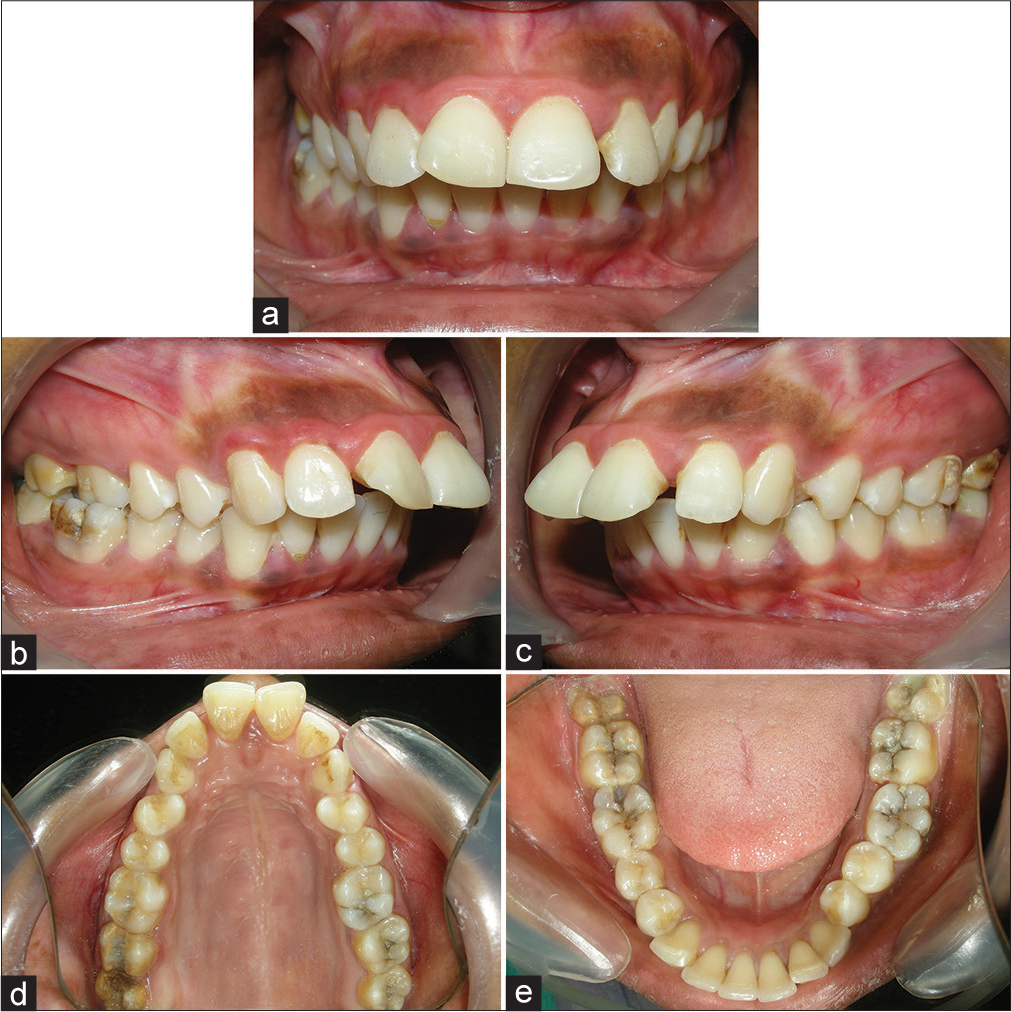
- (a-e) Pretreatment intraoral photographs
| Measurement | Pretreatment | Posttreatment |
|---|---|---|
| Anteroposterior skeletal | ||
| SNA (°) | 82 | 81 |
| SNB (°) | 71 | 73 |
| ANB (°) | 11 | 8 |
| Vertical skeletal | ||
| GoMe-FHP (°) | 38 | 36 |
| FMA (°) | 39 | 37 |
| ANS-Me (mm) | 73 | 70 |
| Dental | ||
| Overjet (mm) | 11 | 2 |
| Overbite (mm) | 2 | 2 |
| U1/SN (°) | 116 | 97 |
| IMPA (°) | 102 | 93 |
| U1-NF (mm) | 34 | 30 |
| U6-NF (mm) | 27 | 24.5 |
| L1-MP (mm) | 51 | 49 |
| L6-MP (mm) | 38 | 38 |
| Soft tissue | ||
| U lip-E line (mm) | +2 | −1.5 |
| L lip-E line (mm) | +6 | +1.5 |
U1-NF – Upper anterior dentoalveolar height; L1-MP – Lower anterior dentoalveolar height; U6-NF – Upper posterior dentoalveolar height; L6-MP – Lower posterior dentoalveolar height
Treatment objectives
Our treatment objectives included improving the patient’s smile esthetics and facial profile along with a harmonious occlusion. This included the following:
Correcting anterior proclination and creating a normal overbite and overjet relationship
Reducing excessive gingival display
Reducing the vertical dimension to improve facial balance
Correcting right molar crossbite.
Treatment alternatives
The following two treatment options were given to the patient:
Conventional orthodontic treatment with extraction of upper and lower first premolars and third molars combined with orthognathic surgery (Le Fort 1 maxillary impaction and augmentation genioplasty)
Extraction of all upper and lower first premolars along with all upper and lower third molars followed by orthodontic intrusion of complete maxillary dentition using absolute anchorage system.
Considering the severity of the case, orthognathic surgery was suggested as the first option, toward which the patient showed reluctance. Both the alternatives were explained to the patient, who chose the more conservative second option. Four maxillary buccal miniscrews and a modified TPA were then used for the intrusion of the entire maxillary arch. Two miniscrews buccally in the lower arch were used to hold the lower arch.
Treatment progress
All upper and lower first premolars along with all upper and lower third molars were extracted. A preadjusted fixed appliance 0.022 × 0.028” slot (MBT prescription) was bonded to the maxillary and mandibular arches. Conventional alignment and leveling were performed in the upper and lower arches. After Six months, alignment up to the 0.019 X 0.025 inches stainless steel arch wires was achieved. Four miniscrews (diameter 1.5 mm and length 8 mm) were placed in the maxillary buccal region and two miniscrews in the lower posterior region buccally under local infiltration anesthesia. A modified TPA was fabricated with 1 mm stainless steel wire and a central acrylic pad such that it stayed approximately 5 mm from palatal mucosa [Figure 3].

- (a-e) Treatment progress intraoral photographs
After 4 months of placement, her two lower miniscrews got loose which were then removed. She was then asked to perform isometric clenching exercises for two 15 min sessions per day (3 s clenching with 5 s rest in between) for whole active treatment and after debonding for 8 weeks.
Closed coil spring (6 mm in anterior) was attached to hooks on either side of the archwire. E-chain was given in the posterior region. This produced intrusion of entire maxillary dentition. The intrusion took approximately 12 months [Figure 4], after which the modified TPA was almost touching the palatal mucosa. The space closure was done by active tiebacks. In this way, the mandible autorotated counterclockwise upward and forward resulting in reduction in anterior facial height and an advancement of chin. Following mandibular autorotation, anterior bite deepened and necessitated the incorporation of the reverse curve in lower archwire to achieve proper overbite. The orthodontic treatment took about 28 months. Fixed lingual retainers were then bonded in both arches.
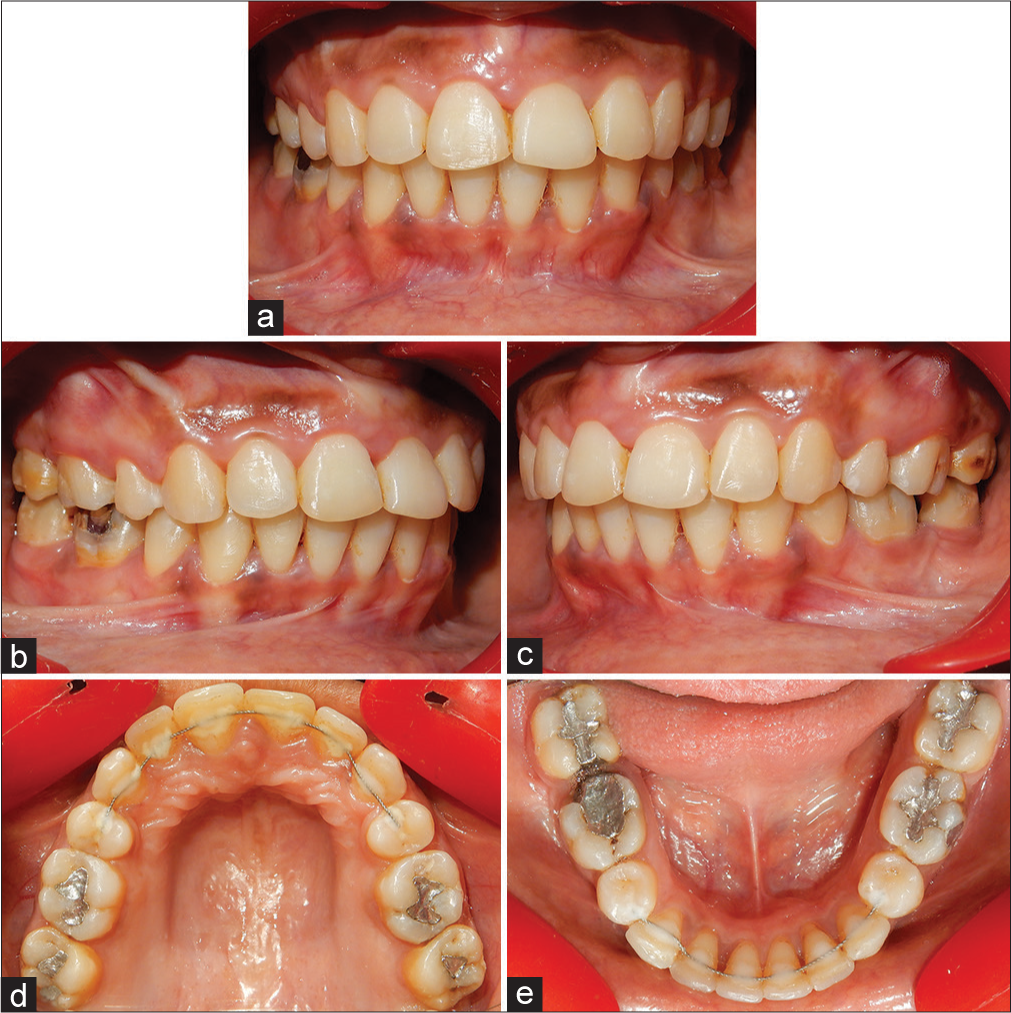
- (a-e) Posttreatment intraoral photographs
Treatment results
At the end of treatment, normal overjet and overbite has been achieved. Lower anterior facial height reduced by 3 mm. The lips and chin appeared more harmonious [Figures 4 and 5]. Mandibular plane angle decreased by by 2° [Table 1]. The posttreatment panoramic radiograph showed overall parallelism of roots. No significant root resorption was noted [Figure 6].

- (a-d) Posttreatment facial photographs

- (a) Pretreatment panoramic radiograph. (b) Posttreatment panoramic radiograph
Overall superimposition of cephalometric tracings showed superior movement of the maxillary dentition and posterosuperior movement of upper incisors with little skeletal change and mandibular counterclockwise rotation. Lower molar showed minimal vertical and anteroposterior change [Figures 7-9].
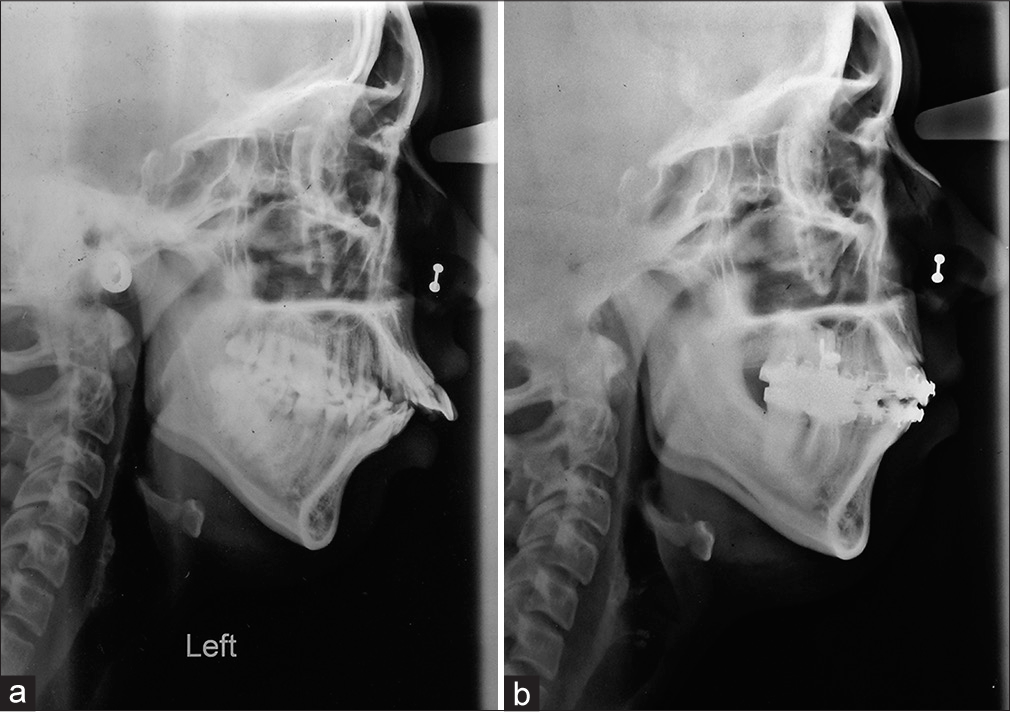
- (a) Pretreatment lateral cephalogram. (b) Posttreatment lateral cephalogram
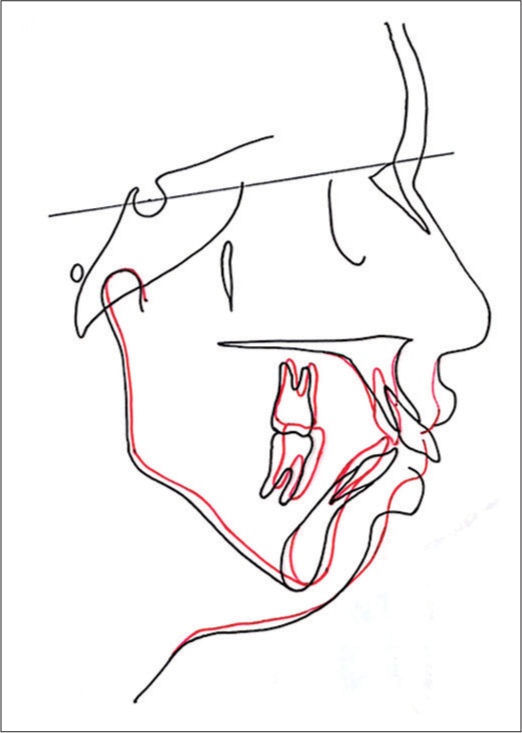
- Superimposition of pre- and posttreatment cephalometric tracings, showing upper molar intrusion, autorotation of mandible, and decrease in lower anterior facial height
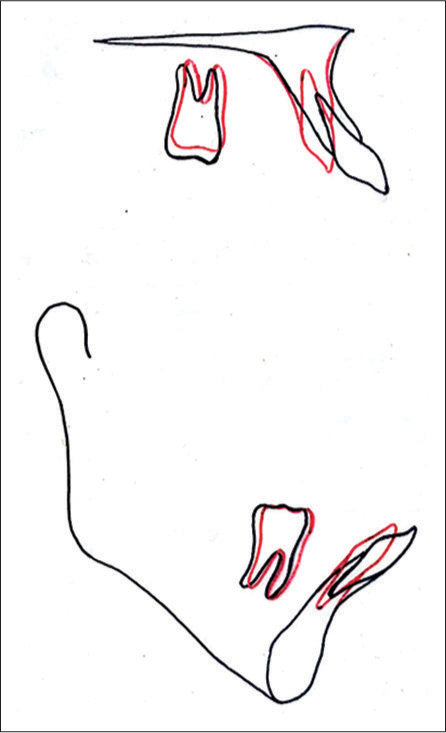
- Regional superimposition tracings
Discussion
Gummy smile can occur due to many reasons such as vertical maxillary excess, excessive gingival overgrowth, altered passive eruption, anatomically short upper lip, hypermobile muscles of the upper lip, or a combination of any of these factors.[5,6] Many a times, orthognathic surgery is required for correction. In this patient, the gummy smile seemed to be a result of vertical maxillary excess.
The use of screw mechanics for achieving the effect of a Le Fort I impaction of the maxilla was proposed by Lin et al.[3] using multiple screws.
Posterior bite block therapy with or without repelling magnets[7,8] has been used in several studies, with results showing reduction in lower anterior facial height. However, patient compliance with such appliances is poor, and temporomandibular joint problems have been reported with the use of repelling magnets. In this case report, four miniscrews along with a modified TPA in the maxillary arch and two miniscrews in the mandibular arch have been used without any problem of patient compliance. This has satisfactorily resulted in the intrusion of entire maxillary dentition. This procedure has been termed by Paik et al.[1] as “slow impaction” of maxilla as it mimics the effects produced by Le Fort I maxillary surgery.
In the lower arch, two miniscrews were placed to prevent overeruption of mandibular molars as the mandible autorotated counterclockwise following maxillary impaction.
Stability has always been a concerning factor following posterior intrusion and reduction of vertical dimension in adult patients. It has been suggested that intrusion of posterior teeth can be maintained by isometric clenching exercises. Chewing gum exercise to increase the contraction forces of elevator muscles of the mandible can be helpful in maintaining the correction. Isometric clenching on soft bite plate for 30 min per day over an 8-week period or two 15 min sessions (3 s clenching with 5 s rest in between) can be done. Alternatively, chewing gum exercise of 30 min per day for 4 weeks can be advised. Following this, total occlusal force was found to be increased by 140% and contact area by 125%.[9,10] Clenching exercises were recommended to this patient.
Conclusion
Correction of gummy smile can be effectively done using miniscrews by the intrusion of maxillary dentition and has replaced the need for surgery in many cases.
Acknowledgment
We would like to thank Dr. Angshuman Bhattacharya (MDS, orthodontics) for his encouragement.
Declaration of patient consent
The authors certify that they have obtained all the appropriate patient consent forms. In the form, the patient has given her consent for her images and other clinical information to be reported in the journal. The patient understands that name and initial will not be published and due efforts will be made to conceal identity, but anonymity cannot be guaranteed.
Financial support and sponsorship
Nil.
Conflicts of interest
There are no conflicts of interest.
References
- Treatment of an adult patient with vertical maxillary excess using miniscrew fixation. J Clin Orthod. 2003;37:423-8.
- [Google Scholar]
- Correction of deep overbite and gummy smile by using a mini-implant with a segmented wire in a growing class II division 2 patient. Am J Orthod Dentofacial Orthop. 2006;130:676-85.
- [CrossRef] [PubMed] [Google Scholar]
- Simultaneous reduction in vertical dimension and gummy smile using miniscrew anchorage. J Clin Orthod. 2010;44:157-70.
- [CrossRef] [Google Scholar]
- Differential diagnosis and treatment of excess gingival display. Pract Periodontics Aesthet Dent. 1999;11:265-72.
- [Google Scholar]
- Severe high angle class II division 1 malocclusion with vertical maxillary excess and gummy smile: A case report. Am J Orthod Dentofacial Orthop. 1999;116:317-20.
- [Google Scholar]
- A clinical assessment of the active vertical corrector – A nonsurgical alternative for skeletal open bite treatment. Am J Orthod. 1986;89:428-36.
- [CrossRef] [Google Scholar]
- Effects of a fixed magnetic appliance on the dentofacial complex. Am J Orthod Dentofacial Orthop. 1989;95:467-78.
- [Google Scholar]
- Daily clenching exercise enhances the occlusal contact. Orthod Waves. 2005;64:29-37.
- [Google Scholar]
- Is chewing Exercise Improving Occlusal Contact? Questionnaire on Manner of Food Taking. In: Presented at 66th Congress of Japanese Orthodontic Society.
- [Google Scholar]






